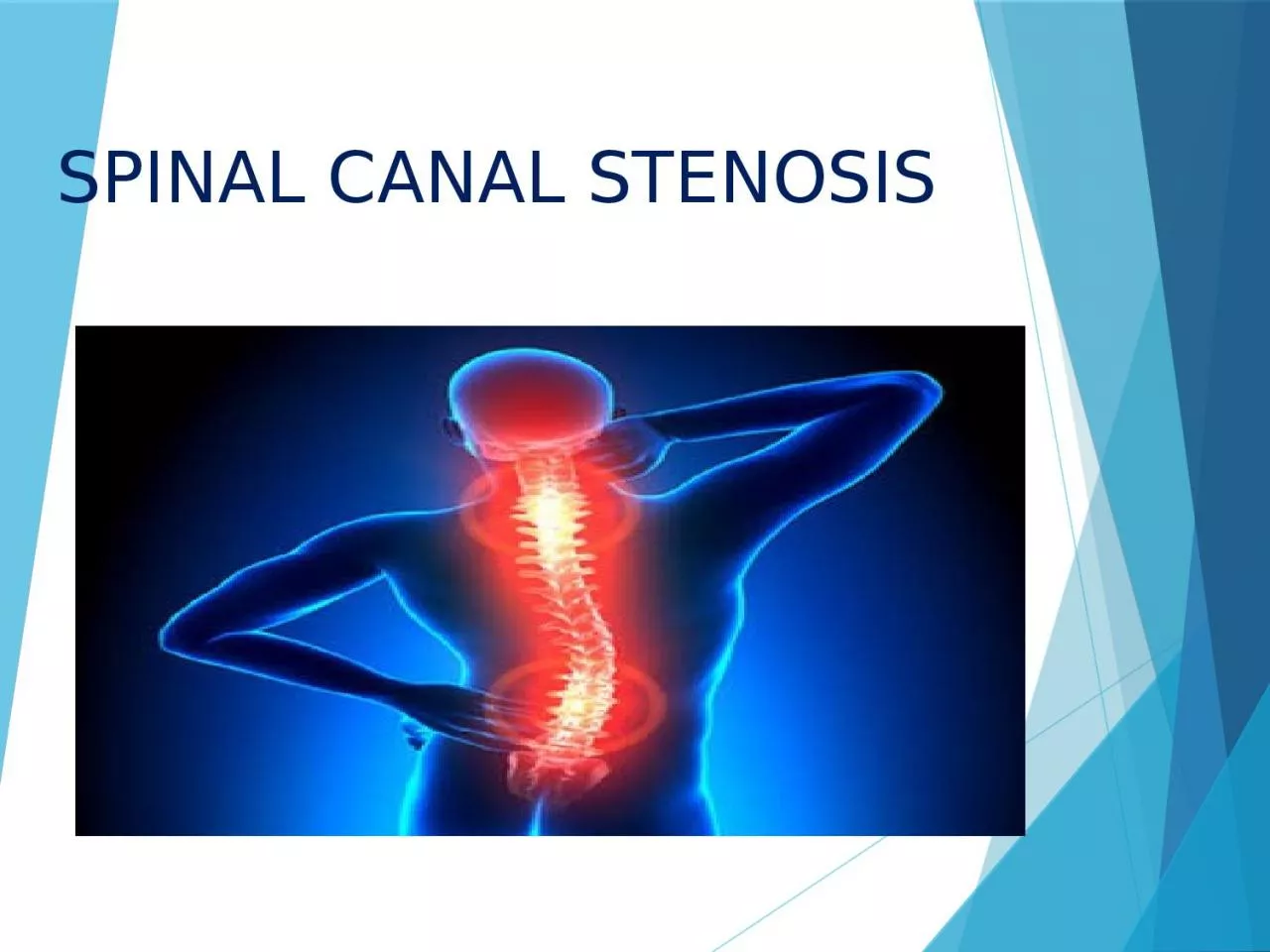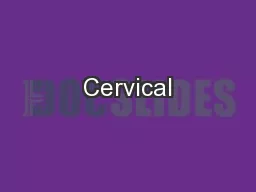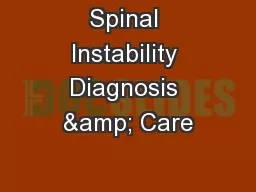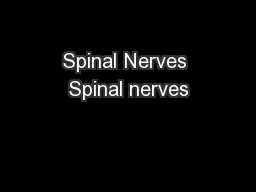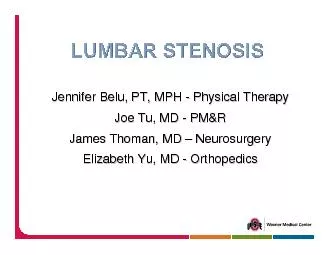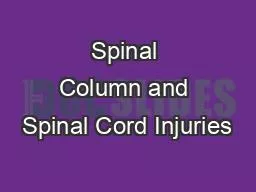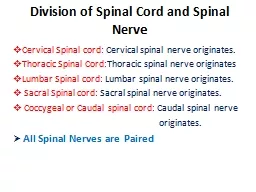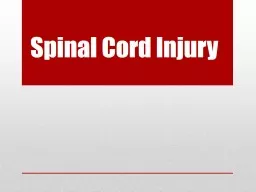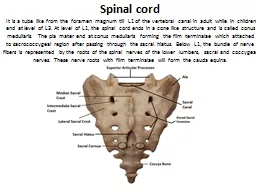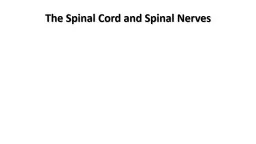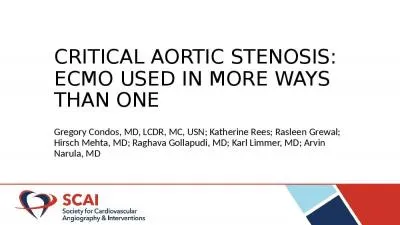PPT-SPINAL CANAL STENOSIS Spinal canal stenosis
Author : samantha | Published Date : 2023-08-30
STENOSIS Constriction of a tube Spinal canal stenosis is defined as an abnormal narrowing of Osteoligamentous vertebral canal or the intervertebral foramina
Presentation Embed Code
Download Presentation
Download Presentation The PPT/PDF document "SPINAL CANAL STENOSIS Spinal canal steno..." is the property of its rightful owner. Permission is granted to download and print the materials on this website for personal, non-commercial use only, and to display it on your personal computer provided you do not modify the materials and that you retain all copyright notices contained in the materials. By downloading content from our website, you accept the terms of this agreement.
SPINAL CANAL STENOSIS Spinal canal stenosis: Transcript
STENOSIS Constriction of a tube Spinal canal stenosis is defined as an abnormal narrowing of Osteoligamentous vertebral canal or the intervertebral foramina causing direct compression or compromise of the dural sac caudal nerve root or their vasculature Producing symptom of rediculopathy or claudication . Atlantoaxial system: anatomy and pathology . Articulation of C1 (atlas) with C2 (axis) is complex, comprising several joints. Median . atlantoaxial. joint. Two lateral . atlantoaxial. joints . These joints are held in place and supported by several ligaments. Decompression: . An . Innovative Treatment for LSS. Sayed . Emal. . Wahezi. , MD. Program Director, Pain Fellowship. Department of Rehabilitation Medicine. Department of Anesthesia. Montefiore Medical Center. Decompression: . An . Innovative Treatment for LSS. Sayed . Emal. . Wahezi. , MD. Program Director, Pain Fellowship. Department of Rehabilitation Medicine. Department of Anesthesia. Montefiore Medical Center. Stenosis. and . Myelopathy. Normal Anatomy. Pathophysiology. Spinal Stenosis. Description rather than a diagnosis. narrowing of the vertebral canal, lateral recess . or. intervertebral foramen . commonly caused by degenerative changes. Instability Parameters. MEASURING INSTABILITY. DENIS 3 Column Classification. Spine Surgery Criteria. Spinal content compromise (spinal cord. . and/or nerves). Heart/Lung Compromise (scoliosis > 60 degrees). 31 pairs arise from spinal cord. Five groups correspond to regions of spinal cord and vertebrae. Cervical 8 pr.. Thoracic 12 pr.. Lumbar 5 pr.. Sacral 5 pr.. Coccygeal 1 pr.. Structure of a Nerve. Case Presentation ReferencesAdvanced Trauma Life Support for Doctors ATLS Student Course Manual 8thed 2008 Chicago IL American College of Surgeons Ahn H Singh J Nathens A MacDonald RD Travers A Tallon J Fehlings MG and ve. . Cervical Spinal cord:. . Cervical spinal nerve originates.. Thoracic Spinal Cord:. Thoracic spinal nerve originates. Lumbar Spinal cord: . Lumbar spinal nerve originates.. Sacral Spinal cord: . Introduction :. 2 General Classifications. Complete Lesion . A lesion to the spinal cord where there is no preserved motor or sensory function below the level of lesion. Incomplete Lesion. A lesion to the spinal cord with incomplete damage to the cord. There may be scattered motor function, sensory function or both below the level of lesion. terminalae. which attached to sacrococcygeal region after passing through the sacral hiatus. Below L1, the bundle of nerve fibers is represented by the roots of the spinal nerves of the lower lumbers, sacral and coccygeal nerves. These nerve roots with film . Spinal Cord. Location. Begins at the foramen magnum . Ends as conus medullaris at L. 1. vertebra. Functions. Provides two-way communication to and from the brain. Contains spinal reflex centers. Figure 12.30. brought to you by CORE View metadata, citation and similar papers at core.ac.uk provided by RERO DOC Digital Library 734dry bone specimens, which would form the basis of com-parative historic studies Gregory Condos, MD, LCDR, MC, USN; Katherine Rees; Rasleen Grewal; Hirsch Mehta, MD; Raghava Gollapudi, MD; Karl Limmer, MD; Arvin Narula, MD. Disclosures. The authors have no relevant financial disclosures..
Download Document
Here is the link to download the presentation.
"SPINAL CANAL STENOSIS Spinal canal stenosis"The content belongs to its owner. You may download and print it for personal use, without modification, and keep all copyright notices. By downloading, you agree to these terms.
Related Documents

